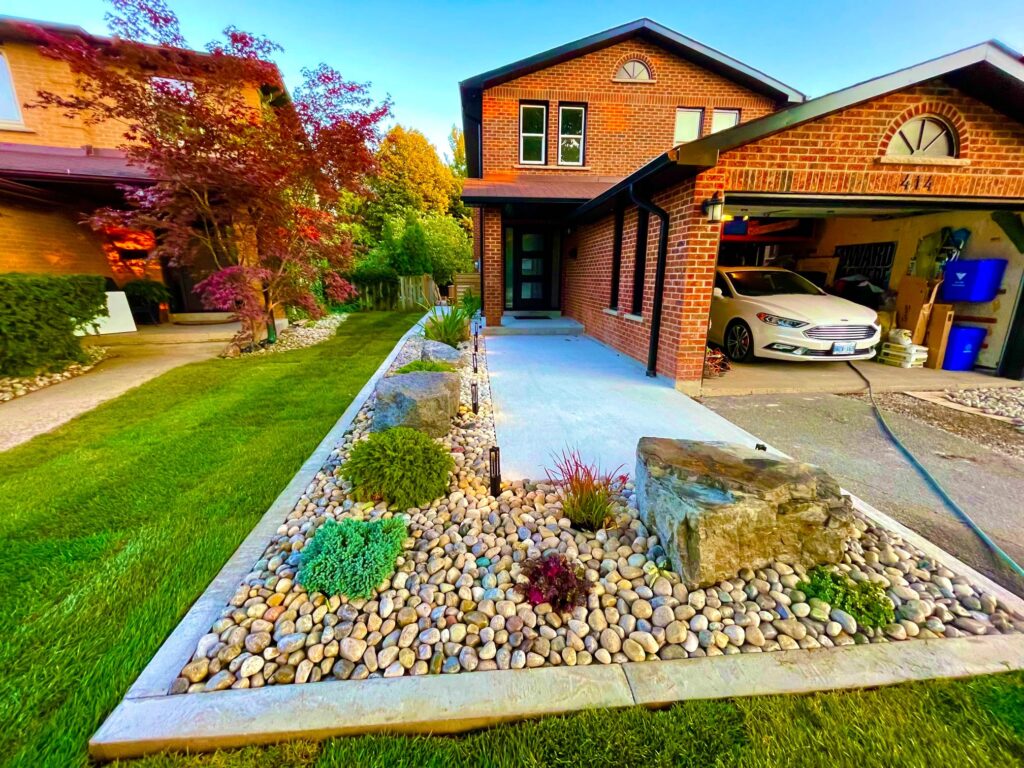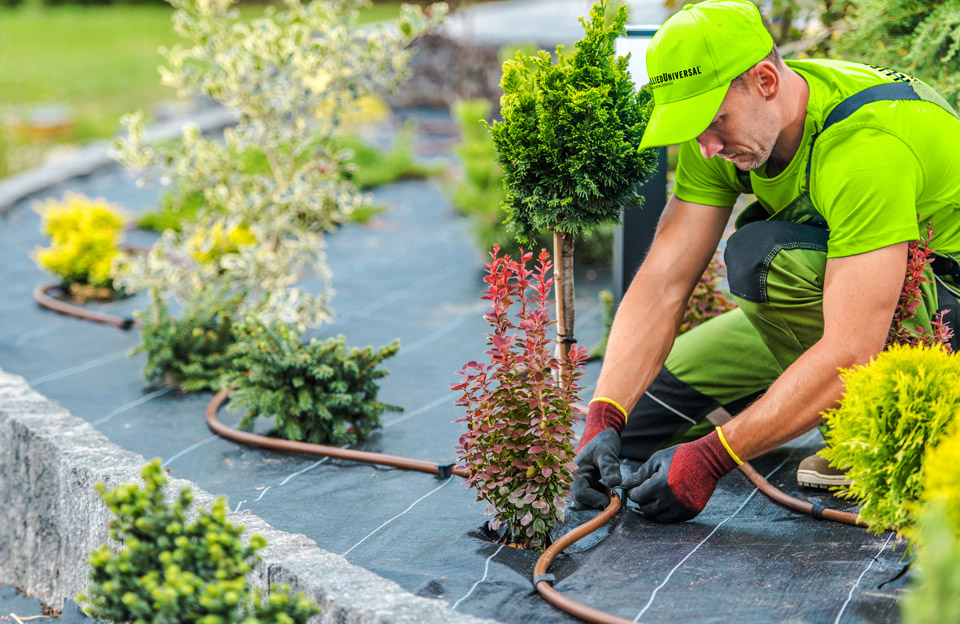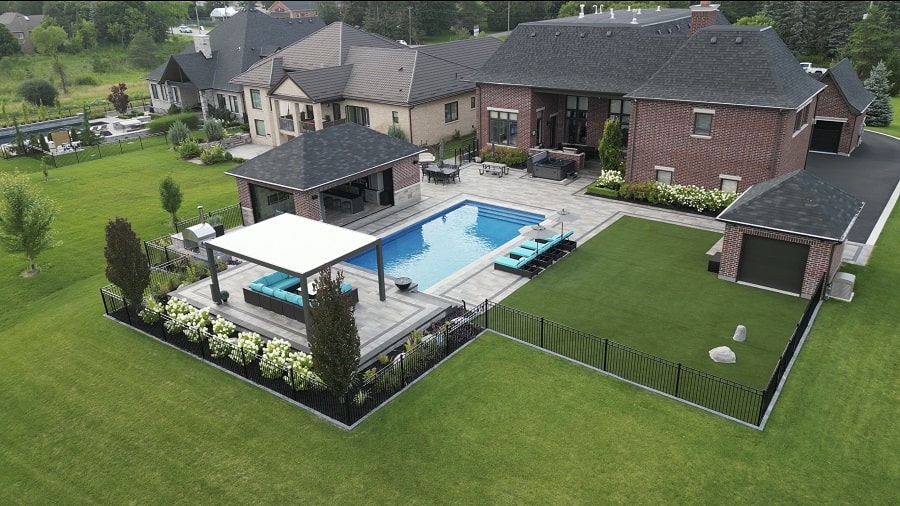Understanding the Comprehensive Scope of Functions in Expert Landscaping Services
The considerable extent of expert landscape design services encompasses a selection of fundamental elements - landscaping. It consists of landscape layout principles, plant selection, and hardscaping features. In addition, it deals with irrigation systems and maintenance strategies. Each element plays an important role in producing functional and cosmetically pleasing outside areas. Understanding exactly how these components collaborate can disclose much concerning the art and science of landscape design. The journey right into this elaborate area is simply beginning.
Landscape Layout Principles
Efficient landscape style principles are vital for producing harmonious outside areas that enhance both aesthetic appeal and performance (Learn More). These principles lead the arrangement of elements within the landscape, ensuring a cohesive visual experience. Trick parts consist of equilibrium, which disperses aesthetic weight evenly; percentage, which associates the size of different elements to each various other and the room; and unity, which develops a sense of wholeness with constant styles and materials

Plant Selection and Installation
In the domain of expert landscaping, plant option and installment play an essential function in achieving a prospering yard. Emphasizing indigenous plant advantages, seasonal considerations, and the certain soil and sunshine needs of each species assures a sustainable and visually pleasing landscape. Cautious preparation in these locations not only improves biodiversity yet additionally advertises long-lasting eco-friendly health.
Native Plant Advantages
Why should house owners think about native plants for their landscaping projects? Indigenous plants provide various benefits that boost both aesthetic appeals and environmental sustainability. They are well-adapted to regional environments, calling for much less water and maintenance compared to non-native varieties. This resilience decreases the demand for chemical fertilizers and chemicals, advertising a much healthier ecological community. In addition, native plants offer habitat and food for local wildlife, consisting of pollinators, which can increase biodiversity in residential areas. Their experience with neighborhood soil and climate condition likewise causes better growth rates and durability. By selecting indigenous plants, homeowners not only produce aesthetically enticing landscapes however likewise add to ecological conservation, making a favorable influence on their neighborhood environment. Native plants stand for a wise choice for landscape design tasks.
Seasonal Plant Considerations
Property owners who have welcomed native plants in their landscaping can further enhance their outdoor spaces by considering seasonal plant choices. By incorporating plants that thrive in details seasons, they can develop aesthetically attractive and vibrant landscapes throughout the year. Spring might introduce dynamic blooms like daffodils and tulips, while summer season can display rich vegetation and vibrant perennials. Autumn introduces a palette of warm tones with asters and goldenrods, while winter can be highlighted with evergreens and ornamental turfs for structure. Expert landscapers frequently suggest selecting plants that not just enhance existing indigenous types but likewise give year-round passion and assistance local wild animals. This thoughtful approach to seasonal plant choice guarantees a continually developing and sustainable yard atmosphere.
Dirt and Sunlight Requirements
Effective landscape design hinges on comprehending the details soil and sunshine needs of plants. Various varieties grow under varying conditions, calling for a careful evaluation of both factors throughout the selection procedure. Dirt kinds, such as sandy, clay, or loamy, impact water drainage, nutrient availability, and root advancement. In addition, pH levels can affect plant health, necessitating dirt testing to identify suitability. Sunlight demands differ significantly; some plants flourish in full sun, while others choose complete or partial shade. A professional landscaper thinks about these components to assure peak development and visual charm. By aligning plant options with the setting's details characteristics, landscapes can achieve sustainability, durability, and aesthetic consistency, inevitably resulting in effective plant establishment and long-lasting maintenance.
Hardscaping Functions and Construction

While landscaping commonly stimulates pictures of lavish greenery and vivid blossoms, hardscaping functions play an essential function in defining outdoor spaces. These elements, that include patios, sidewalks, retaining wall surfaces, and decorative stonework, offer structure and performance to gardens and backyards. Hardscaping makes use of materials such as concrete, stone, timber, and brick, enabling varied layouts that enhance the natural landscape.
The building and construction of hardscaping functions calls for mindful planning and execution to assure resilience and aesthetic appeal. Professionals evaluate website conditions, drainage, and spatial connections to produce cohesive exterior atmospheres. Correct installment methods are vital, as they protect against concerns like disintegration and shifting with time.
Integrating hardscaping not just improves the visual interest of a property yet likewise helps with outside tasks, making it a basic aspect of extensive landscaping services. Inevitably, thoughtful hardscaping adds to both the capability and appeal of outdoor spaces.
Irrigation Systems and Water Management
Efficient irrigation systems and water administration are essential elements of professional landscape design, as they guarantee that plants get the necessary hydration for suitable development. These systems can differ from easy drip watering configurations to sophisticated automated lawn sprinkler systems, made to satisfy the specific needs of varied landscapes. Correct water administration not only maximizes water use, reducing waste, but likewise enhances plant health and lessens condition dangers.
Landscape design specialists evaluate numerous aspects, including soil type, plant species, and neighborhood environment, to establish tailored irrigation services. Furthermore, integrating rain harvesting strategies can better enhance sustainability and efficiency. Regular maintenance of watering systems is vital to preserve performance and stop leaks, which can bring about water loss and boosted expenses (Learn More). Inevitably, a well-designed irrigation system plays a critical duty in maintaining the aesthetic allure of outdoor spaces while promoting ecological stewardship within professional landscaping practices
Yard Treatment and Upkeep Methods
Grass treatment and upkeep techniques are essential for achieving a lavish, healthy and balanced backyard that enhances the general landscape. These methods incorporate different methods focused on advertising perfect growth and visual charm. Regular mowing is essential, as it urges thick, even growth while protecting against weeds from establishing. In addition, appropriate fertilization offers essential nutrients, with applications customized to the certain turf type and soil problems.
Watering techniques ought to focus on deep, occasional irrigation to encourage root growth, while aeration improves dirt framework and advertises nutrition absorption. Bug and illness management is also vital; determining problems early permits effective treatments that minimize damage.
Lastly, overseeding can renew slim or broken yards, boosting thickness and color. By carrying out these targeted grass treatment methods, landscape design specialists can assure that lawns stay healthy and balanced and dynamic throughout the periods, significantly adding to the overall beauty of the residential or commercial property
Seasonal Landscape Care and Maintenance
As the periods change, proper landscape care becomes vital for keeping the health and wellness and charm of outdoor spaces. Each season presents special challenges and needs. In spring, landscape specialists focus on trimming, planting, and feeding to urge development. Summer demands routine watering, weed control, and pest administration to shield recently developed plants.

Throughout the year, seasonal landscape maintenance guarantees that exterior areas stay healthy and visually appealing. Specialist services can supply tailored upkeep strategies that adjust to the certain requirements of each season, permitting homeowner to appreciate vivid landscapes year-round. Generally, seasonal treatment is a crucial aspect of specialist landscape design that advertises longevity and visual value.

Sustainable Landscaping Practices
An expanding number of residential or commercial property proprietors are embracing lasting landscape design techniques to create eco-friendly outdoor areas. These methods concentrate on saving resources, enhancing biodiversity, and reducing environmental influence. Indigenous plants are usually picked for their low tide requirements and compatibility with neighborhood communities, reducing the requirement for chemical fertilizers and pesticides. Rainfall gardens and absorptive paving are utilized to handle stormwater runoff, promoting groundwater recharge and lowering disintegration.
In addition, sustainable landscape design incorporates organic horticulture strategies that focus on dirt health and advertise natural insect control. Reliable watering systems, such as drip irrigation and rain harvesting, assistance enhance water usage. Furthermore, landscape developers increasingly support for using recycled products, such as reclaimed timber and stones, to lessen waste. By embracing these sustainable methods, residential property proprietors not only contribute to eco-friendly conservation yet also produce visually pleasing settings that can thrive with minimal upkeep.
Regularly Asked Concerns
How much time Does a Landscape Design Task Commonly Require To Full?
Commonly, a landscape design project can take anywhere from a few days to several weeks to finish, relying on the task's dimension, intricacy, and style needs. Aspects such as weather and source accessibility also affect timelines.
What Variables Influence the Expense of Landscape Design Services?
Different factors influence landscape design service prices, including job dimension, design intricacy, worldly top quality, labor expenditures, geographic area, and seasonal demand. Each component adds distinctively to the general economic requirements of a landscape design job.
Are Landscaping Provider Available Year-Round?
Landscape design services are generally offered year-round, although availability might differ based upon area, seasonal weather, and specific solution offerings. Some services could be limited throughout extreme weather or off-peak seasons.
Do Landscaping Firms Offer Warranties on Their Job?
Lots of landscaping firms do supply warranties on their work, which can vary in size and coverage. Clients are urged to here ask about certain terms, guaranteeing they comprehend what is assured and any kind of conditions that apply.
Can I Layout My Landscape Without Specialist Assist?
Yes, individuals can design their landscapes without professional aid. They might do not have competence in plant selection, layout, and environmental factors to consider, possibly leading to much less effective styles that could call for costly adjustments later on.
In the domain of expert landscaping, plant option and installment play a critical function in accomplishing a growing yard. Home owners that have actually accepted indigenous plants in their landscape design can better improve their exterior rooms by taking into consideration seasonal plant selections. Successful landscaping hinges on understanding the details soil and sunlight demands of plants. Effective irrigation systems and water administration are important components of expert landscaping, as they guarantee that plants receive the required hydration for perfect development. Landscape design experts assess numerous aspects, including soil kind, plant types, and local environment, to establish customized irrigation options.